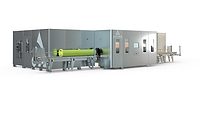New depositors, dividers, and rounders for efficient dough handling
Manufacturers strive for fast, accurate, customizable machines.

courtesy of Hinds-Bock Corp.

courtesy of Unifiller

courtesy of Rheon USA

courtesy of Reiser

courtesy of Koenig Bakery Systems USA





Snack and bakery companies that work with dough, or looser components like batters, fillings or toppings, turn to manufacturers of depositors, dividers and rounders to cut, divide, portion and round or mould their products—and the equipment continues to get faster, more accurate, more customizable and easier to clean, among other winning qualities.
Flexible depositors
Unifiller, Delta, British Columbia, has launched two depositors in recent months—the servo-driven Rotary Piston (RP) Depositor for batters like gluten-free doughs and stiff brownies, and the Uni-Dopositor dough depositor and extruder used primarily for cookie doughs.
The RP Depositor is cantilever designed to go into the front of an oven, says Stewart MacPherson, vice president of sales and marketing. The unit is “extremely high speed,” he says, and takes up about 18 inches of width of a conveyor. The RP Depositor also features interchangeable parts and power wash that lets the machine handle a complete changeover in under five minutes.
“We can also use it for spreading,” says MacPherson. “Instead of multiple port outlets, we can have one or two slot openings, and we can deposit, or fill and spread, at the same time. That might be useful if someone was looking to do a layer of dough, or gluten-free, in the bottom of a tray.”
Portions and speeds are servo-controlled, and settings for recipes can be established through a touchscreen interface on the machine. With 26-inch and 18-inch models, the machine provides accurate portion control, gentle portioning for delicate products and a submerged rotary piston to eliminate the possibility of air pockets in deposited portions.
The Uni-Dopositor offers flexibility to change from a single port to multiple ports to suit different pan configurations, MacPherson says. “As long as you’ve got the custom change parts, which would be specified up front, that’s the secret. We need to make sure the customer gives us different configurations, and we’ll provide them with the tooling.” It has adjustable conveyor guide rails, a user-friendly interface with 100 recipes and a gentle-action roller design that’s easy on the product, yet easily handles stiff batters or particulates like chocolate chips or nuts.
Hinds-Bock Corp., Bothell, WA, has released two depositors: the Model 5A-SD target depositor for streusel and other baked goods like muffins, cupcakes and pies; and the 40P-01 Dual High Speed Mini Products Depositing System for mini muffins, brownies, cupcakes and snack cakes.
The Model 5A-SD cuts labor costs and provides accurate target scaling of high-fat streusel. The machine is available in a variety of widths to match pan and speed requirements, while quick-change chutes provide greater versatility so you can run several pans with the same machine. Customers can order spreading blades for Bundt and round layer cake pans.
The 40P-01 runs at speeds up to 2,800 per minute. The heavy-duty sanitary conveyor accurately locates pans through magnetic restraining flights, while servo motors drive metering pistons, depositor orbit and actuators. The color touchscreen provides recipe control to instantaneously recall all depositor profiles, and it can be taken apart in minutes without tools for cleaning.
“There’s been a strong push from food manufacturers to incorporate flexibility and technology into equipment design—this push is usually based on consumer demand,” says Lance Aasness, vice president, Hinds-Bock. “For example, there’s demand for new products with untraditional serving sizes, such as single-serve portions.”
Axis Automation, Hartland, WI, has seen greater demand from manufacturers who want to apply a wider range of materials with greater accuracy, says Neil Anderson, business development manager. In addition to staples like salt, sugar and chocolate chips, they have seen requests for materials like quinoa, seaweed, seed and fruit blends, and exotic grains, and the company is designing depositor systems to handle those materials with repetitive accuracy.
“Accuracy is key, as many of these materials are expensive, and zero waste is paramount,” Anderson says.
Exacting dividers
Rheon USA, Irvine, CA, has released three new dividers. Two are variations of the company’s line of V4 stress-free dough sheeting systems—the VX 122 three-row system and the VX212 fixed-width divider—and the other is the V4 flex divider often used for artisan-type bread lines, says John Giacoio, national sales director.
The VX122 works well for customers who are looking to vary dough width, from 8 inches up to 15 inches wide, through the use of a cross-roller. This can include those looking to produce ciabatta in 3x3 or 4x4 rolls, for example. The VX212 produces bread like Italian flatbreads or sourdough baguettes with high portioning accuracy and easy production changeover.
“Rheon is pretty well known for its stress-free systems,” Giacoio says. “We have several of them depending on what the bakery is looking to make, size-wise. The machine puts down the dough, drops a chunk, makes another chunk, forms a continuous sheet of dough, and the weighing machine weighs it, guillotines it and weighs again.”
The V4 flex divider helps those trying to do a wide range of artisan products who need different dough widths, Giacoio says. “That machine allows you to adjust the width of the divider, so you take less trim,” he says. “For example, with something 22 or 23 inches wide, you want a very wide dough sheet. But if you’re going to switch over to two lanes, you don’t want a dough sheet out that wide. The divider will allow us to adjust width with a push of a button.”
Baker Perkins, Peterborough, England, has released the Accurist 2.1 bread dough divider, which the company says provides improved product quality through gentle handling of dough and servo control automation that reduces dough damage by minimizing shear, compression and ram movement. The Accurist 2.1 can be supplied with 3 to 8 pockets, providing outputs of 1,260 to 14,400 pieces per hour, with a weight range of 6.2 to 58 ounces.
“Pressure on the product is cut, reducing dough stress while maintaining scaling accuracy,” says Dan Christie, senior account manager. “Quality benefits include up to 15 percent increase in cell count, up to 20 percent increase in softness, greater volume, improved crumb development and better color. Wear is also minimized by efficient lubrication, minimum ram movement, low-pressure operation and long-life components.”
The divider boosts sanitation through chemical foam-and-rinse, Christie says. “All mechanisms between the frames of the divider are now made from stainless materials, while sealed-for-life bearings allow cleaning of all areas of the divider where oil and product debris may collect. Allergens and pathogens are a rising concern for bakeries and are reliably removed by this method.”
Reiser, Canton, MA, has developed Vemag dividers for bread and rolls with double-screws that have turned the machines into “continuous pocket dividers,” says John McIsaac, vice president, strategic business development. “Our advances in controls allow us to tie into any line and give the operators easy recipe-driven menus,” he says. The company is introducing systems to easily extract weight data for analysis, he adds.
WP Bakery Group USA, Shelton, CT, produces dividers under the brand names WP, WP Kemper, WP Haton and WP Winkler, says Patricia Kennedy, company president. The company stresses accuracy—for example, its bagel divider handles 100 strokes per minute with ±1 percent error rate. “This is a very rapid ROI,” she says. “Our WP and Kemper roll dividers are able to handle many types of doughs with very accurate dividing, and on the bread side, our WP Haton dividers are able to handle all types of doughs with accuracy.” This includes more-challenging high-absorption doughs like ciabatta.
Data management plays into this, given how “weight adjustment via program control and a protocol of each machine module helps in keeping a consistent product and aids in finding problem areas if mistakes are made,” says Kennedy.
Multifaceted rounders
Koenig Bakery Systems USA, Ashland, VA, has released a combined dough divider and rounder called the Rex Futua Multi that produces 9,000 pieces per hour and is designed for hamburger buns, hot dog buns and sub rolls. The machine handles a weight range of 0.6 to 8.6 ounces with six-row operation and exchangeable rounding plates. Removable hopper duster unit, rounding plates and drum ledges allow for easy cleaning.
Koenig also produces the Industrie Rex Compact AW divider and rounder, which combines high weight accuracy, gentle dough processing and a weight range of between 0.99 and 12.33 ounces, with three different nominal widths for 3–10 rows. The hourly capacity reaches 30,000 pieces in the 10-row setting.
And for those with high hygienic demands, Koenig offers the Industrie Rex AW-H divider and rounder, with lightweight retractable drawers integrated into the machine frame, main drives encapsulated and separated from the dough area, a duster and fan unit that swivels and allows easy access to the drum rounding unit, and a completely removable inner rounding drum.
Rheon USA has released the 2-Lane Punch Rounder, which produces gentle rounding not unlike what could be produced by hand, Giacoio says. The machine starts at 150 grams and goes up to 800, with flexibility depending on dough density. The punch rounder can create a ball shape from two lanes simultaneously for products like ciabattas or baguettes.
The Conical Rounder from Baker Perkins gently rolls divided dough pieces with an open trough profile to preserve internal dough structure, Christie says. “As well as forming the ball shape, the process conditions the surface of the dough pieces for easier handling downstream. To prevent dough adhering to surfaces, contact parts are made from polymer or have long-lasting, non-stick coatings, and there is a fully integrated air blowing system, so no oil or flour dust is required.” A flour duster can be supplied if desired.
Reiser’s Vemag rounder air-drying systems allow customers to reduce or, in some cases, eliminate dusting flour, McIsaac says, and the innovative bar design has expanded the number of sizes it can run. “We are also advancing the rounding systems used here with multi-axis rounding. The same setup can produce plain hamburger buns, as well as the ‘hybrid’ style rolls quick-serve restaurant customers are demanding.”
Custom jobs
Reiser has a team of engineers that works on custom solutions for individual needs, including products like injection systems to produce marble ryes with color injection, machinery to add cheese and other fillings into pizza crusts and filled breadsticks, and systems to cut high-speed bars, filled cookies and gluten-free products of all shapes and sizes.
Customers have asked Axis for a variety of spot-topping systems that target a deposit of a measured amount of material onto a designated product, Anderson says. “The target can either be a regular baking pan with various-sized cavities or items deposited directly into the oven band.”
Koenig dividers and rounders can be custom-configured depending on the needed rows, weight ranges, strokes per minute, dough consistencies, processed materials, machine control and hygienic design.
Koenig also has seen greater demand for artisan bread baking, with dough that needs longer resting times and has a higher water content. This necessitates dividing and processing that’s gentler so that the dough keeps its structure, which means the use of gravimetrically working dough sheeting lines. The company’s Menes Dough Sheeting Line, which handles up to 1,100 pounds per hour with thicknesses of between 0.04 and 2.8 inches, meets these needs.
This article was originally posted on www.snackandbakery.com.
Looking for a reprint of this article?
From high-res PDFs to custom plaques, order your copy today!










